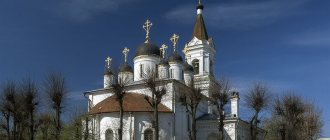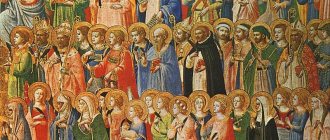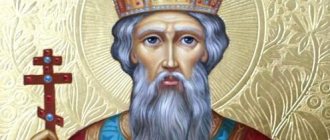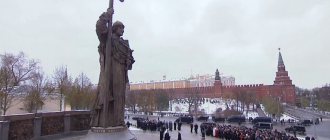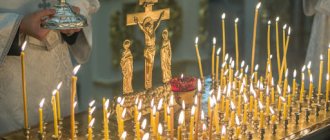The crown of Russian temple architecture
And Ivan the Terrible himself was noted for the construction of the famous St. Basil's Cathedral. Its architect was Pskov resident Barma Postnik, a religious man with a deep sense of Slavic roots. The Tsar demanded that he create something unprecedented, extraordinary - and the Russian architect succeeded. Despite the complete asymmetry of its nine domes, the temple looks very harmonious, and the variety of colors and ornaments create a festive mood.
According to legend, Tsar Ivan Vasilyevich liked the temple so much that he ordered... to blind the architect so that he could not create such a miracle anywhere else. https://zen.yandex.ru/media/cyrillitsa.ru/kto-post...-rusi- 5b7907cb5d4ed100a9277ec8
Destruction and revival of temples
The development of ancient Russian architecture stopped for half a century after the invasion of the Mongol-Tatars. For various reasons, craftsmen, icon painters and builders transferred to the Horde, some churches and temples were destroyed.
Moving away from Byzantine models, the most ancient churches of Rus' in the 12th century acquired distinctive features, determining the development of Russian architecture.
Everything a schoolchild needs to know about the life of Ancient Rus' is set out in the educational materials for grade 6. Ancient Rus' is the history of our ancestors, the formation, battles, victories of our state, which every Russian should know about.
Stone construction
Stone construction is associated with the Baptism of Rus'. The first stone temple of Ancient Rus' is the one that was founded in Kyiv by the architects of Constantinople. Historians consider the date of this event to be 989. Before that, there were also temples, but of wooden construction.
If you believe the chronicles, the construction of the temple was completed in 996, and the solemn consecration took place at the same time.
Saint Sophia Cathedral. The only surviving ancient Russian temple with Byzantine mosaics
Mosaic finishing is a rather complex and expensive technique. But the Kyiv princes tried to equal the Byzantine emperors, and therefore a number of capital churches, like Byzantine ones, were decorated with mosaics. Alas, only one such temple has survived to this day - the Cathedral of St. Sofia. Of course, other churches in the city were also decorated with mosaics: the already mentioned Church of the Tithes, the Assumption Cathedral of the Kiev Pechersk Lavra and St. Michael’s Golden-Domed Cathedral. But almost nothing remains of these decorations. Only some of the mosaics of St. Michael's Golden-Domed Cathedral were preserved, and now they can be seen in the choirs of St. Sophia Cathedral and in the Tretyakov Gallery in Moscow. But in the St. Sophia Cathedral all the mosaics are in their place. See our special material about this.
Mystical connection
The fates of many people associated with the Tithe Church developed dramatically. Its founder, Prince Vladimir, died while preparing to go to war against his son Yaroslav. And after the death of the Baptist of Rus', his sons immediately got involved in a bloody fratricidal war. It is worth remembering the Kursk landowner Alexander Annenkov, who initiated the restoration of the Tithe Church in the 19th century. Even then, historians began to suspect that his good intentions were just a cover. In fact, he was driven by the desire for material gain - he was looking for legendary ancient Russian treasures. And even, according to rumors, he found it. However, the treasures found did not bring Annenkov happiness: he became an alcoholic, squandered his property, did not leave a good memory, and his only pride - the rebuilt church - was destroyed. Archaeologist Kondrat Lokhvitsky in his essays did not hide the fact that he began to engage in amateur archeology for the sake of fame, honor and awards. However, his plan for the restoration of the Tithe Church was not recognized by either Metropolitan Eugene or the imperial commission due to numerous shortcomings. But the Russian professor of architecture Nikolai Efimov actually made a fairly accurate plan for the foundations of the church. However, his project did not pass either. The fates of a number of archaeologists who explored the shrine at the beginning of the 20th century were completely tragic. Dmitry Mileev died of typhus during excavations. Sergei Velmin and Feodosia Molchanovsky were repressed in the 1930s. The only “lucky” person from this group of antiquity researchers was the Leningrad archaeologist Mikhail Karger. But his archive with all the results of the excavations of the Church of the Tithes disappeared without a trace.
Illumination of the Church of the Assumption of the Blessed Virgin Mary in Kyiv. Miniature from the Radziwill Chronicle, 15th century
Italian architects in Russia
The next wave of temple construction occurred during the reign of Ivan III. This king married Sophia Palaeologus, who was a descendant of the Byzantine imperial house, but lived in Italy. This was a woman who was unable to personally enrich Russian culture and morality, but outstanding artists and architects came to Russia with her.
They talentedly combined Russian style with Italian architectural forms. The Church of the Archangel Michael in the Kremlin is decorated with zakomaras in the shape of shells - everyone liked this technique and began to be actively used in the construction of temples.
Many people are familiar with the beautiful Church of the Ascension in Kolomenskoye. This is a new hipped style of temple architecture. This temple was built in honor of the birth of Ivan IV the Terrible, also by an Italian architect.
Surviving autographs of the Kyiv princes
St. Sophia Cathedral is also unique in that you can see the autographs of the Kyiv princes in it, according to archaeologists. And these are not signatures on state acts, but prayer requests inscribed on temple walls. At this point, the autographs of Princess Olisawa and her son, Prince Svyatopolk II of Kyiv, have been identified. You can also read a separate article about this on our portal.
From Abbot Nazarius to Abbot Damascene
Valaam Monastery under Abbot Innocent
Innocent, abbot of the Valaam Monastery. Unknown artist c. XVIII – n. XIX century
Since 1801, Innocent became the abbot of the monastery, who invariably helped Nazarius in all his affairs. Judging by the construction that unfolded under the new rector, he had an excellent artistic sense. Under the leadership of Innocent, the construction of the outer monastery quadrangle surrounding the inner square began. It is possible that the idea of creating additional external buildings was conceived under Nazariy. Confirmation of this is the too short time interval between Nazariy’s retirement and the beginning of the construction of the external square.
Innocent energetically continued the work of his predecessor. From 1801 to 1809, stone two-story buildings were built on the outer square of the monastery buildings on the east, west and south sides. During the construction of the stone Holy Gate in 1805, the construction of the gate stone Church of Peter and Paul above it was completed.
In 1807, on the northern side of the outer square, construction began on a stone hospital with a hospital church of the icon of the Life-Giving Spring, consecrated in 1814. In 1809, a stone chapel was built on Krestovy Island, at the entrance to the bay leading to the monastery. In 1811, all buildings in the monastery were made of stone.
When constructing the outer square, the architects unknown to us thought about the ensemble as a whole. Both squares have architectural, artistic and figurative unity. They have a common character of construction, a single system of seemingly flowing spaces. The design of the churches of Peter and Paul and the Life-Giving Spring icon, located symmetrically relative to the cathedral and executed in a single order with its architecture, also speaks about the ensemble.
So, in a short period of time, a large monastery complex grew up, the number of monks approaching a hundred.
In April 1822, a decree followed, which “out of respect for the ancient existence and improvement of the Valaam Spasopreobrazhensky cenobitic monastery... ordered that it be elevated to the 1st class”[4].
Architectural page: External bob
Jonathan I, abbot of the Valaam Monastery
Valaam Monastery under Abbot Jonathan I
From 1823 to 1830, during the reign of Abbot Jonathan, construction work was carried out in the internal and external monastery square. A two-story stone outbuilding was built on the northwestern side of the outer monastery building, and a one-story stone outbuilding was built on the northeastern side. In addition, a stone fence was erected around the brotherly cemetery[5].



